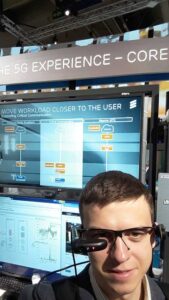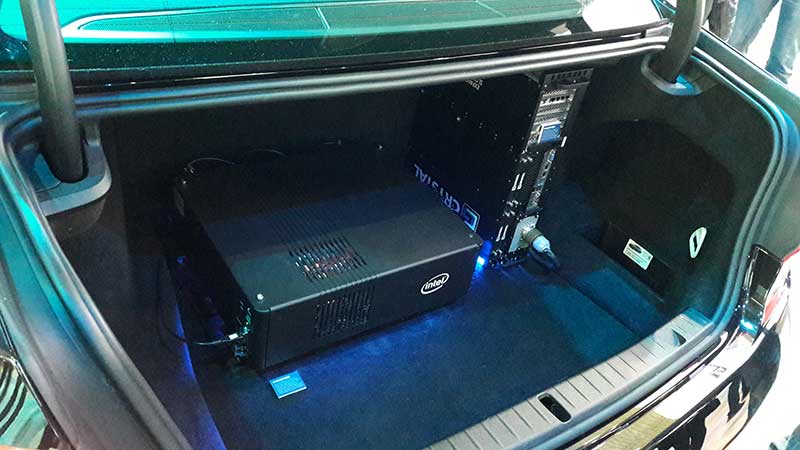-
-
-
-
URL copied!
Introduction
This year, the Mobile World Congress (MWC) took place in Barcelona, Spain. More than 108,000 visitors from over 208 countries visited this annual event, where the most prominent companies in the industry showcased the newest technologies and most innovative products for the mobile industry.
The most popular demos at MWC17 revolved around Virtual Reality (VR), Augmented Reality (AR), chatbots, and personal digital assistants (powered by AI). Most importantly, nearly every top vendor and operator had something to say about 5G and IoT. Let’s take a closer look at these two important drivers of technological disruption.

5G
Opportunities for Operators
5G provides operators with an opportunity to move beyond connectivity (i.e., remove “tele” from “telecommunications”) and to collaborate across sectors (e.g., finance, transportation, energy, manufacturing, education, agriculture, retail, health) to deliver new services and find new revenue streams. 5G is the key to making mobile networks a general-purpose technology like electricity. It’s a future-generation platform for the next decade and beyond.
Opportunities for Vendors
Revenues for infrastructure vendors like Ericsson, ZTE, and Nokia are being squeezed. As of January 2017, a total of 581 commercial LTE networks have been launched globally, and all indicators point to a year of LTE decline as a result of diminishing rollouts worldwide. So there is a gap between 5G equipment sales beginning and 4G equipment sales lagging. Another worry point for telecom equipment makers is the growing momentum of programmable and software-centric networks, which is being driven by the adoption of Network Function Virtualization (NFV) and Software-Defined Networking (SDN) approaches. This evolutionary leap has led to the introduction of a wide range of innovative pure software players (e.g., Big Switch Networks, Affirmed, etc.), primarily because networks are being increasingly commoditized and intelligence is moving to the software layer.
This is one reason why most vendors and operators are pushing a 5G rollout —it brings new markets and revenue streams.


5G Use Cases
I saw several interesting demos around autonomous vehicles, such as the first live pre-5G over-the-air wireless interoperability between the third generation of the 5G Intel Mobile Trial Platform (i.e., UE) and the Ericsson 5G Radio Prototype system. This accomplishment was demonstrated live over-the-air at MWC via two use cases: virtual reality and autonomous driving. For the automotive use case, there was a demonstration of 5G 28GHz over-the-air connectivity between an Ericsson base station and an Intel GO Automotive 5G Platform located in the trunk of a BMW 740i (see Figure 1). These two tech giants conducted the most number of public demos around 5G by far at the event.
 Figure 1. Intel GO Automotive 5G Platform in the trunk of a BMW 740i
Figure 1. Intel GO Automotive 5G Platform in the trunk of a BMW 740i
Other interesting 5G demos included the 3.6 Gbps for 5G Connected Car (Ericsson and BMW), the first 5G remote driving concept, as shown in Figure 2 (Telefonica and Ericsson), and the world’s first intercontinental 5G trial network (SK Telecom and Ericsson).
 Figure 2. 5G remote driving concept
Figure 2. 5G remote driving concept
The other prominent event around 5G was the Global 5G Test Summit. Supported by industry organizations like 3GPP, ITU, NGMN, GTI, and GSMA, this event brought together global operators, vendors, and telecom organizations from across the mobile industry. During the Summit, 25 mobile operators announced that they are lab-testing 5G — twelve of whom reported having progressed to field testing and four of whom announced plans for 5G trials (according to a report by Viavi Solutions). The event concluded with the release of a “Global 5G Test/Trial” declaration, which aims to promote a unified standard and accelerate the maturity of the 5G industry towards commercial deployment by strengthening cooperation between vendors, telecoms operators, and vertical industry partners.
IoT
Operator Opportunities
The 3GPP-approved LPWA standards in the latest 3GPP Release (June 2016) for the licensed spectrum provide operators with new IoT opportunities while allowing them to continue using their existing LTE networks. These standards cover LTE Machine-Type Communication (LTE-M) and Narrowband IoT (NB-IoT), and both run on LTE networks. The NB-IoT commercial deployment will be fast, as carrier existing networks can be updated to support NB-IoT with just a software update. In 2017 alone, over 25 NB-IoT networks (e.g., Vodafone, DT, Telefonica, China Mobile, KT, etc. ) will be deployed in more than 20 countries across the world. Such fast adaptation is being driven by the benefits that this technology brings to the market, namely: better indoor coverage, multi-year battery life (more than10 years with two AA batteries), reduced device costs (less than 5 US dollars per module), and significant coverage extension over existing cellular technologies.
LPWA Opportunities
Various LPWA solutions were on display across the conference area, highlighting industry support for technologies such as smart manholes (Ericsson, Intel, Telit ), smart buildings (Ericsson, Intel, Gemalto), connected factories (Ericsson, China Mobile, Intel, Fibcom), smart gas meters (Nokia, Telit), smart buildings (DT, Ista), safety jackets (KT, Kolon Industries), smart parking (Huawei and Vodafone), and lost & found tracker (Telefonica). Most of these deployment-ready concepts are end-to-end “sensor-to-cloud” solutions and demonstrate the business case of NB-IoT, leveraging features like low data rates, low battery power, extended coverage, and pure data-only applications with a fixed installation.
IoT Use Cases
This year, the main focus of IoT use cases was on enterprise and industrial applications, as vendors seek to promote IoT’s role in industrial transformation. General Electric (GE), Qualcomm, and Nokia showcased a private LTE network in an unlicensed spectrum for Industrial IoT (IIoT) use. Moreover, the companies announced plans to lead live field trials this year based on this demonstration, which are designed to promote the digital transformation of industrial processes. In another interesting demo, Korea Telecom partnered with clothing manufacturer Kolon to create a connected jacket (Figure 3) that is designed for use in remote locations. It can sense the unusual movements of a person in danger or distress and then automatically send signals to rescue teams.
 Figure 3. IoT Safety Jacket
Figure 3. IoT Safety Jacket
IoT brings efficiency for everyone, and pets are no exception. Telefonica demonstrated an IoT dog health and activity tracker (Figure 4) that can track and analyze its activity. It provides information on how active the animal was throughout the day and whether the activity goal has already been achieved. Based on the collected data, the smart device provides individual recommendations on how a dog owner can move, feed, and keep his/her dog healthy.
 Figure 4. IoT Smart Pet Tracking (right) and Dog’s Profile (left)
Figure 4. IoT Smart Pet Tracking (right) and Dog’s Profile (left)
Nevertheless, a lot of challenges remain around a lack of interoperability across multiple standards and platforms, fragmentation, security and identifying business models.
Accelerators for 5G and IoT
Here are some key takeaways from MWC17 regarding how software development can accelerate the mass rollout of 5G and IoT solutions:
- Agile operation processes like DevOps have inspired continuous integration, allowing the whole industry to change rapidly.
- Businesses need to adopt new approaches to building software for NFV/SDN (e.g., an evolution from VM-based implementation to microservices-based architecture with the help of container technology such as Docker) because the use of 5G and IoT will connect millions of devices and result in enormous numbers of sessions within networks. By utilizing a microservices architecture, operators can improve their speed in setting up these sessions, more efficiently manage the number of sessions per server, and lower the end-to-end costs of processing all these transactions.
- The benefits of a microservices architecture and Agile development and DevOps processes require true business transformation, encompassing processes, engineering, operations, IT organization, and culture.
- Businesses need to balance Edge Computing and Cloud Computing. Edge Computing refers to storing data processing power at the edge of a network instead of a cloud or central data warehouse. The main reason for deploying Edge Computing is to significantly reduce the network latency boosting performance for time-critical applications like autonomous vehicles, industrial IoT, remote surgery, robotics, and all the IoT objects that will be created during the next decade. In addition, it’s the logical next step for computer industry, just as centralized mainframes led to decentralized client-server architecture, which then swung back towards centralized Cloud Computing. It’s highly likely that in the future we will observe a paradigm shift towards decentralized Edge Computing. We can already observe several alliances in the market, such asOpenFog Consortium, the ETSI Mobile Edge Computing (MEC) group, and OpenEdge Computing. At MWC, Huawei also launched the Edge-Computing-IoT (EC-IoT)
- To improve a competitive position, a number of forward-looking telecom service providers and network equipment makers have embarked on a process to explore the advantages of open source in projects such as OCP (Open Compute Projects), OSM (Open Source MANO), CNCF (Cloud Native Computing Foundation), OCI (Open Container Initiative), CORD (Central Office Re-architected as a Datacenter), ONAP (Open Network Automation Platform) (i.e,. a merger of Open Source ECOMP and OPEN-O projects).
Conclusion
Vendors and operators are making eager progress towards the advancement of 5G commercial rollout and massive IoT availability across the globe — both from technology and commercial perspectives. MWC 2017 demonstrated the significant work being done by industry players across multiple areas to bring these technologies to the mass market, with clear use cases being developed for both businesses and end users.
Another key point is that the move to software-centric networks will lead to a wave of innovation and a growing number of new providers offering new services; the network itself becomes an API (Application Programming Interface). Future generations of product development services for the communications industry will be one of the drivers that will speed up transformation in this area.
Top Insights
Manchester City Scores Big with GlobalLogic
AI and MLBig Data & AnalyticsCloudDigital TransformationExperience DesignMobilitySecurityMediaTwitter users urged to trigger SARs against energy...
Big Data & AnalyticsDigital TransformationInnovationRetail After COVID-19: How Innovation is Powering the...
Digital TransformationInsightsConsumer and RetailTop Insights Categories

Let’s Work Together
Related Content
GenAI in Action: Lessons from Industry Leaders on Driving Real ROI
Generative AI (GenAI) has the potential to transform industries, yet many companies are still struggling to move from experimentation to real business impact. The hype is everywhere, but the real challenge is figuring out where AI can drive measurable value—and how to overcome the barriers to adoption. In the latest episode of Hitachi ActionTalks: GenAI, … Continue reading Mobile World Congress 2017 Recap: The Year of 5G and IoT →
Learn More
Unlock the Power of the Intelligent Healthcare Ecosystem
Welcome to the future of healthcare The healthcare industry is on the cusp of a revolutionary transformation. As we move beyond digital connectivity and data integration, the next decade will be defined by the emergence of the Intelligent Healthcare Ecosystem. This is more than a technological shift—it's a fundamental change in how we deliver, experience, … Continue reading Mobile World Congress 2017 Recap: The Year of 5G and IoT →
Learn More
Share this page:
-
-
-
-
URL copied!